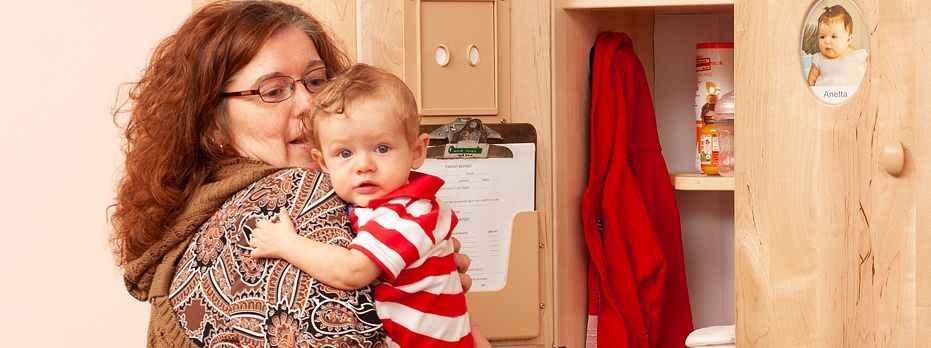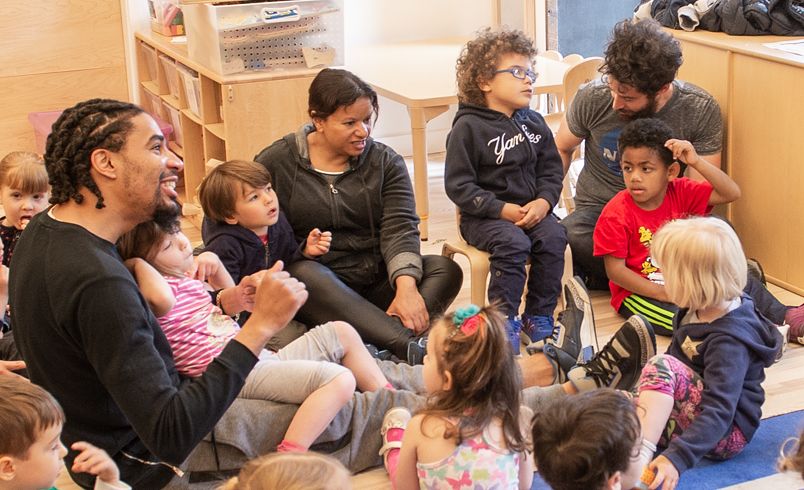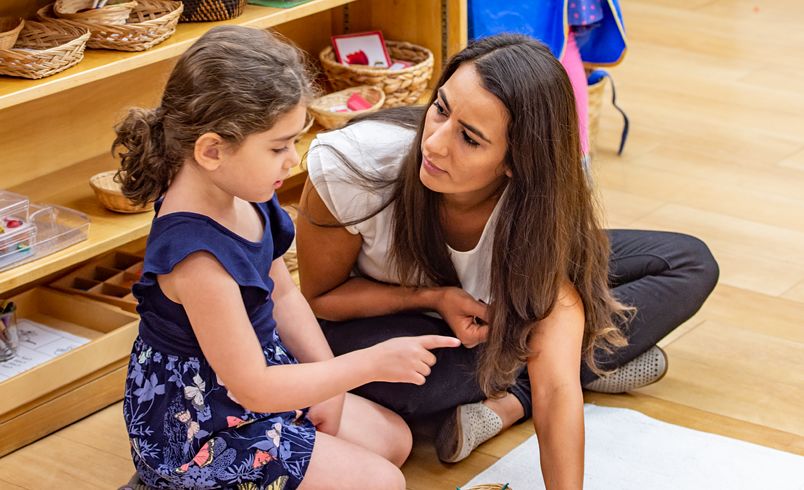Building Connections with Families
Three Strategies to Strengthen Relationships between Families, Teachers, and Childcare Programs
| January 2019Mia’s alarm goes off at 6:00 a.m. She reaches over her sleeping four-year-old, who snuck into her bed sometime during the night. In the kitchen, she finds her spouse, who is packing lunches for the family. They check in about who will be picking up their children from childcare before he leaves for work. On her bus ride to work, her mother calls, concerned about a leak in her roof. Mia offers her the name of a handy-man she knows, but her mother is worried about the cost. Mia’s father passed away recently, and it has been a hard adjustment for everyone. Just before she arrives at work, Mia receives a text from her best friend, inviting her to a family barbeque over the weekend. As she walks into school, she runs into her program director, who lets her know that a new child will be joining her class today. She greets her co-teacher, who smiles warmly but looks exhausted—she had a baby a few months ago and didn’t get much sleep last night.
Mia’s busy morning isn’t unusual—many of us have lots of interactions before we even start our work day. Before the first child arrives in her classroom, she has spoken with her spouse, her mother, her best friend, her supervisor, and her co-teacher. Now, close your eyes for a moment and imagine the five most important people who share your daily life, the ones who have the greatest impact on the tone of your day—your Invisible Crowd. These might be your spouse or partner, your children, the family who raised you, your mentors, your coworkers, or others. Some of the influences are positive and supportive, others may be less so. Imagine those people standing in your classroom with you.
Now, imagine that each child in your class brings the five most important people in their lives with them into the classroom, each offering their own influence on the child’s day. The room quickly becomes very full! While this is an exercise of the imagination, the influence of all these people is real. They can impact children’s schedules, interactions, eating and sleeping patterns, and their ability to manage their emotions. One way we can manage this Invisible Crowd is by mindfully cultivating positive, welcoming relationships with families—the most important people in children’s lives. Here are three ways to build connections that benefit families, children, teachers, and childcare programs alike.
1. Be a good listener.
Children are beginning to arrive for the day. Mia knows this can be a challenging time for some, so she offers a wide variety of soothing, child-directed play opportunities, prepared in advance so she can be free to help children transition. The option of appealing activities like play-dough or dramatic play helps children to get started on their own, allowing her a chance to chat casually with families. She checks in with Kaylen’s family, knowing they recently moved, and asks Mailk’s family how their new baby is doing. This morning, she also blocked out a little extra time for Olivia, the new student who has just arrived. She wants to go over the new student questionnaire with her parents before sending it home with them.
Being a good listener isn’t something we are necessarily born with, but it is a skill we can develop the ability to do. There are concrete steps you can take to let families know that you are really listening to what they have to tell you. First, start with a good questionnaire for new families in your classroom, inviting them to share their family life with you. Your commitment to welcoming every child and family can start here, by offering a flexible way for families to tell you about themselves. (For example, one school district asks families to list “people who live together and share your daily life,” instead of pre-assigned blanks for “mother” and “father,” letting all configuration of families know that they, too, are welcome and seen.) Another important way to validate unique family culture is by recognizing home languages. You can let families know you are listening by offering your questionnaire and other important school materials in more than one language whenever possible There are many other ways to let families know you value their individual make-up and needs. Small steps can make a big difference over the long term.
On a daily basis, small steps matter even more. One simple way to create moments for listening is to build in mindful arrivals and departures. Over the long term, this allows time to connect with families in your day-to-day routine. Check-ins can become a natural part of the beginning and ending of the day, leaving unhurried time to find out more about how the previous night went or if anything unusual might be happening after school. This brief time will help you build a relationship with families that can help you celebrate success and meet challenges together as allies.
2. Embrace families as the first experts on their children
As teachers, we sometimes overlook the experiences children bring with them when they walk into our classrooms. But as our Invisible Crowd exercise shows us, children have full lives outside of school. Families are the best window into this larger world.
In addition to a welcoming, flexible initial questionnaire and built in time for listening, offer plenty of structured and unstructured opportunities for families to tell you more about their child. Curriculum and classroom life can be developed around invitations to share more. Here are a few ideas for including families in classroom life:
- A naptime playlist compiled of each child’s or family’s favorite lullaby
- Classroom displays of children with the important people in their lives
- A class or school-wide potluck that invites families to share a favorite dish
In addition to curriculum activities, consider adding a “What’s New?” section to your regular newsletter, asking open-ended questions that invite families to tell you more about what is happening at home. Here are some ideas for questions:
- Describe your child’s favorite part of the day.
- What new skills is your child practicing?
- What helps your child feel better when they are having a hard day?
- What things does your child want to do again and again?
These questions can provide you important insight into children’s temperaments and home life, as well as offering you conversation points to build your relationship with families.
Included in the information she sends home at the end of the week, Mia includes a quick note to Jada’s parents: “Thank you for letting me know Jada is so excited about dinosaurs! I used our classroom dinosaurs for a sorting activity today and she was so engaged. She came back to do it again later, on her own during center time.
Earlier during the week, Mia used this inspiration and added a couple of pictures of dinosaurs to the wall near the art station. Several of the children, including Jada, noticed and added dinosaurs to their artwork this week.
3. Share strategies that are working
As experienced teachers know, challenges at school often overlap with challenges at home. Your teacher training may have offered you developmentally appropriate strategies for addressing these challenges in the classroom, and there may be ways to implement them at home, too. Offer resources to families to learn about development and cope with the challenges that are a normal part of parenting young children.
You might include helpful hints in your regular newsletter or share online resources via email or your school’s social media outlets. If many children you work with are going through the same developmental stages together (teething or toilet training, for example), parenting workshops might be another option. Knowing a few reliable sources for supportive strategies can go a long way in building your relationship with families. Here are a few great places to find information on child development and ideas that may be helpful to families:
- ZERO TO THREE
- NAEYC for Families
- The Center on the Developing Child at Harvard University
- Two resources from this author might also be helpful. (See reference list.)
One caution—if you are sharing resources related to challenging behaviors, be careful to avoid assigning blame. Instead, collaborate with parents with the shared goal of helping the child succeed. Some classroom challenges are related to things happening at home, which may or may not be within the family’s control. However, plenty of challenges in an early childhood classroom are also developmental. Your mindful work to be a good listener and to validate families as experts on their children can set the foundation for you to work together to find a solution that is best for the child, their family, and for you, the teacher.
Mia is finishing up her day in the classroom. The children have left, and she is tidying up before she heads home herself. As she tucks an art project into Aiden’s cubby, she remembers that his grandmother had expressed some frustration with their toilet training efforts and asked for advice. She uses their classroom communication app to send an article she had recently bookmarked on signs of a child’s readiness to toilet train and ways to manage if he or she isn’t quite ready yet. She includes a short note: “This might be helpful!” She takes a last look around before she turns off the lights, ready to turn her attention to her family at home.
References:
Forrester, M. & K. Albrecht (2014). Social emotional tools for life: An early childhood teacher’s guide to supporting strong emotional foundations and successful social relationships. Tomball, Texas: Innovations Press.
Fiechtner, J., M. Forrester & K. Albrecht (2018). Five parenting strategies to support emotional development. Tomball, Texas: Innovations Press.









